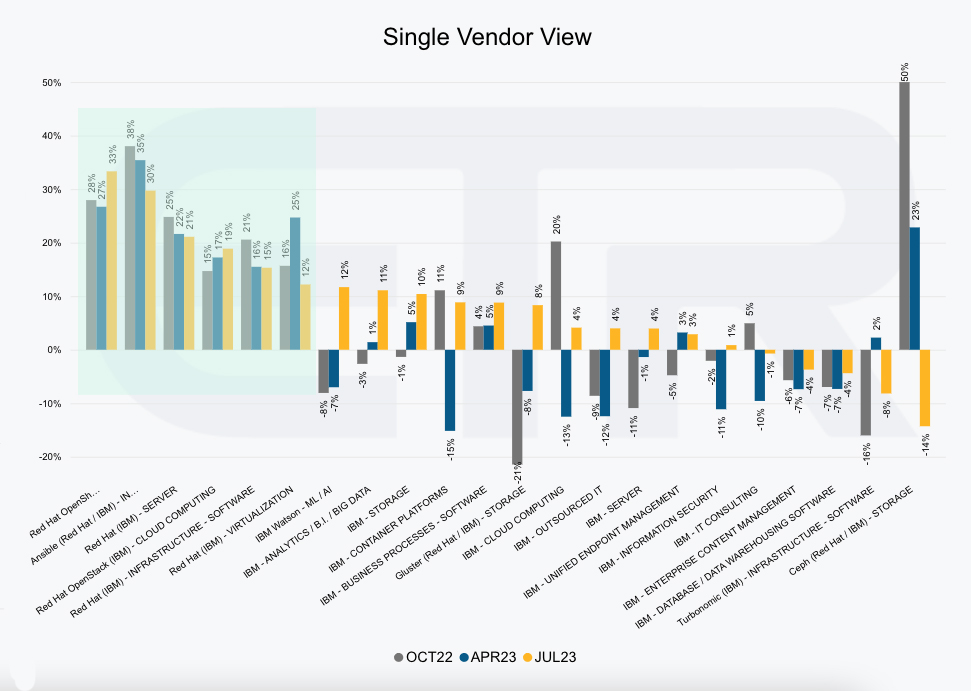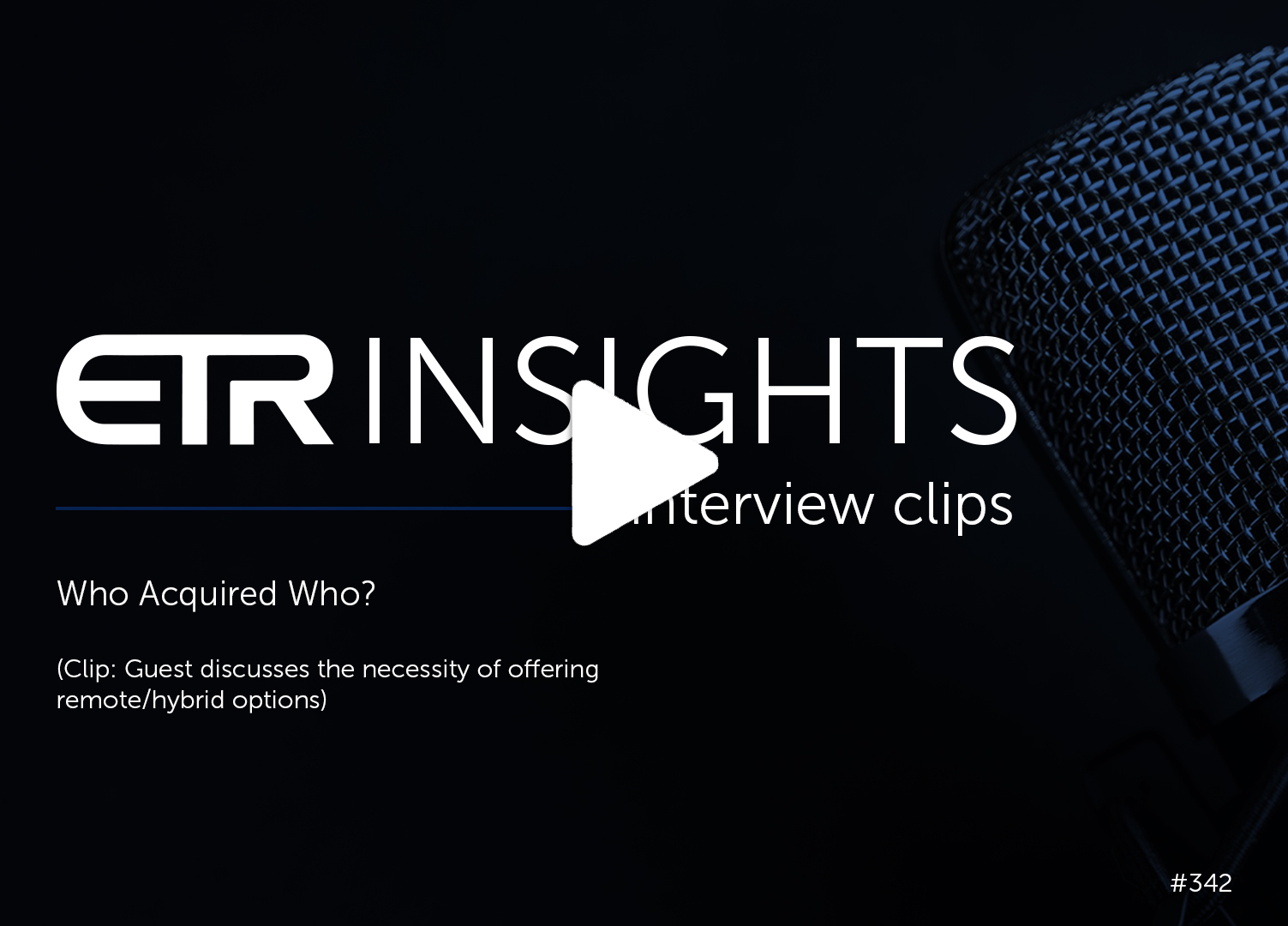ETR Insights presents an interview with the Senior Director of Technology Integration at a small technology enterprise, who notes an uptick in auditing activities and a trend toward IT budget consolidation into comprehensive platforms.
As remote working becomes the new norm, companies are restructuring their work and hiring strategies. Our guest discussed interest in generative AI, explained their firm’s shift from AWS to Azure, and highlighted the growing importance of software and data insights over networking hardware. Read on to learn more about Cloudflare’s surprising market share in the enterprise, how Salesforce is successfully rebranding itself as “accessible,” and why perspectives on open-source security and support are quickly evolving.
Vendors Mentioned: Akamai / AWS / Ansible / Auth0 / Barracuda Networks / Cisco (Meraki) / Cloudflare / GitLab / Google / HPE / IBM (Red Hat) / Microsoft / NETGEAR / Okta / OpenAI / Oracle / Palo Alto / Riverbed / Salesforce / SentinelOne / SonicWall / Tanium / Ubuntu / Verisign / VMware / Wiz
IT Spending and Enterprise Trends
In a tightening economy, our guest’s consulting firm often sees an uptick in auditing activities, which generally leads to a reassessment of IT budgets. “We start at the year-end budget in October, saying we’re going to ask for 5.6%, but we’re really going to spend 3.6% because we can go through and cut some things.” They observe a trend toward consolidation in IT spending, specifically onto comprehensive platforms like Microsoft, which now offer various degrees of enterprise licensing and are pushing to onboard frontline workers and consolidate a company’s telephony and other piecemeal software.
Amidst the backdrop of grim employment data following the economic downturn, businesses are adapting their work structures and hiring strategies in the face of new work-from-home norms. GitLab stands out as being especially intentional about its approach, appointing a C-suite executive to manage remote operations. According to our guest, the rise of remote work and hybrid working models isn’t just an effect of the pandemic; it has merely confirmed an ongoing shift. Having a physical office is no longer an immediate concern for many businesses, and organizations that do not offer remote work options could struggle to attract talent. “When we’re talking knowledge work – when we’re talking accounting functions, legal functions, and HR functions – I’d say 80% of the job description is remote capable.” This executive is concerned about a culture of hybrid in-person and remote work, where employees might struggle with blurred lines between office and home life.
Vendor-Specific Commentary
OpenAI, Big Data + Generative AI. Our guest commented on the surge in interest in generative AI, specifically large language models like OpenAI’s ChatGPT, but points out we have been using them for years. “They have names like Alexa, ‘Hey, Google,’ Cortana, and Clippy.” While companies were previously focused on generating insightful data, data today is so abundant that accessing it without code or traditional software is nearly impossible. “Now just to use natural language to request information, to ask for it in a certain format – which is the code generation part – that’s kind of the new thing.” Microsoft’s Copilot Project and Google’s Bard may soon seamlessly intermix personal data with public data for more accurate and relevant responses; our guest imagines this will enhance worker creativity and problem-solving capacity, but that these services aren’t yet at a level where they would replace human jobs. “The whole idea in enterprise is to increase the workers’ ability to think, creativity, and ability to solve problems that aren’t just a regurgitation of data, but are now looking at the data as a human does and synthesizing a solution, versus having to sift through the data to present it to yourself.” They liken AI to the iPhone touchscreen, which didn’t introduce a new technology, but combined existing technology to dramatically improved the user experience.
Cloud platforms v. legacy HPE and IBM. Seeing Microsoft’s products as superior, this firm chose to pivot from AWS to Azure a few years ago, exemplifying the increasing competition among cloud service providers and the importance of a comprehensive and efficient product suite to attract and retain customers. “Before, in my previous venture at a design firm with some heavy graphics loads, it was in VMware and AWS, because AWS was the first one to add graphics functionality to their stack.” Our guest imagines that any ongoing company use of HPE on-premise technology is simply a product of inertia and brand name familiarity. They suggest that Red Hat is singlehandedly buoying IBM. “Who acquired who?”

Open source. Our guest references Red Hat, Ubuntu, Ansible, and the continuing impact of the open source movement. “Windows has been able to keep up on the OS side now with Ubuntu, and they’ve got a user interface on the Ubuntu side. Red Hat and their enterprise-level interface is competitive as well.” They emphasized that software must be quickly fixable when it breaks and not open systems up to security threats. Increasingly active developer communities and improved attitudes toward security counter an older notion that open-source options lack support or are insecure.
Salesforce. Our guest spoke positively about Salesforce’s efforts to position itself as accessible with minimal IT overhead, comparing it to user-friendly offerings from Microsoft and Google. They praised Salesforce’s focus on serving the SMB segment. “With Salesforce, it really feels more like the ‘new’ Oracle or the ‘new’ Sun Systems, for the SMB player who just wants to log in and use some products.”

Cloudflare. ETR data suggests spending intentions for Cloudflare remain high, with Net Score exceeding 40% and outpacing established competitors like Google, Salesforce, and VMware. Our guest’s personal experience with Cloudflare’s OpenDNS service reinforces the brand’s credibility, though they expressed surprise at Cloudflare’s strong position given its relatively recent market entry. “I know they had enterprise systems, but I did not expect them to see them that high.”
Cybersecurity. Cyber threats have evolved; the industry today is less about fighting user-level threats and more focused on redundancy, air-gapping, and emergency management planning. “If you don’t build your system to turn back up separate from your system because you’ve been crypto-locked, then that’s your fault. You haven’t put in the appropriate planning, version control, or things like that.” Tanium, SentinelOne, and Cloudflare score well in trust, alongside established players like Akamai and Verisign. Okta and Auth0 are top when it comes to certificates and communication verification, the backbone of Web 2.0. Our guest is unsure if any of these vendors have ventured into blockchain technology or Web 3.0. “Everybody’s afraid of the security of Web 3.0 because of anonymity.” Microsoft remains a safe choice for security – “Nobody in a large enterprise organization gets fired for buying Microsoft” – while choosing a popular but lesser-known vendor like Wiz could potentially be career-risking if a security incident were to occur.
Networking. Choosing between platform providers like Cisco and Palo Alto versus a best-of-breed collection of tools largely depends on a company’s network setup and specific needs. “Cisco and Palo Alto probably have more of the mobile and the optionality to spend on 5G networking and things like that.” While hardware-based systems like Cisco’s remain relevant, the future will favor more agile, adaptable solutions. Hardware-based solutions like SonicWall and Barracuda must pivot. Our guest highlighted the increasing need for data insights beyond basic network monitoring; they mentioned how Meraki, for example, can deliver heat maps of a workspace, helping commercial real estate make more efficient decisions about space utilization. Riverbed and NETGEAR have been less successful in this transition, according to this ITDM.
